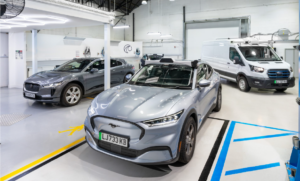
Wayve looks to create AI autonomous driving products for OEMs with $1B investment
By onMarket Trends | Technology
Wayve recently announced a $1.05 billion Series C investment to integrate AI into autonomous driving with plans to sell the technology to OEMs once further developed, according to a company press release.
The company also received investment contributions from NVIDIA and its existing investor, Microsoft.
“The integration of Embodied AI into vehicles and robots will lead to a paradigm shift in how machines interact with and learn from human behavior in real-world environments,” the release says. “This innovation holds tremendous potential to enhance the usability and safety of autonomous driving systems, empowering them with the intelligence to confidently navigate situations that do not follow strict patterns or rules, such as unexpected actions by drivers, pedestrians, or environmental elements.”
Wayve claims to be the first to develop and test AI autonomous driving on public roads. The release says its models are similar to “GPT for driving,” which allows the vehicle to perceive its surroundings.
“By leveraging Wayve’s advanced proprietary tools, OEMs and fleet owners can generate valuable data assets that bridge the gap between raw data and unparalleled driving capabilities,” the release says. “Moreover, the company’s research on multimodal and generative models, known as LINGO and GAIA, is driving the automotive industry towards a future where AI in vehicles can offer advanced features like intuition, language-responsive interfaces, personalized driving styles, and co-piloting to enhance the automated driving experience.”
Alex Kendall, Wayve co-founder and CEO, says in the release that the funding will help the company develop and launch products for the automotive industry.
“At Wayve, our vision is to develop autonomous technology that not only becomes a reality in millions of vehicles but also earns people’s trust by seamlessly integrating into their everyday lives to unlock extraordinary value,” he said.
Kentaro Matsui, SoftBank Investment Advisors partner, board member, and head of the New Business Office, said AI allows vehicles to interpret their surroundings like humans.
“The potential of this type of technology is transformative,” Matsui says in the release. “It could eliminate 99% of traffic accidents.”
According to a New York Times article, the company has about 300 employees and has been testing its technology on British roads since 2018.
The company’s approach to autonomous driving differs from Waymo, which depends heavily on high-definition maps, sensors, and laser tools, the article says. The company’s technology instead has an approach similar to Tesla.
“Wayve has been building software to explain in plain English why a car made a certain driving decision — like why it stopped suddenly or slowed down — a layer of transparency to help win over regulators,” the article says.
Legislators in California have been proposing bills to restrict autonomous driving in the state.
Assemblymember Phil Ting (D-District 19) introduced AB1777 Jan. 3. The bill would require manufacturers to set up a dedicated emergency response telephone line that is available to first responders by July 1, 2026. It also requires manufacturers to equip AVs with two-way voice communication devices to allow nearby responders to speak with a remote human operator.
The vehicles would also authorize emergency response officials to issue a geofencing message that would direct AVs to leave or avoid an area. The bill says the vehicles should act on the message within two minutes of receipt. Manufacturers also will be required to report any collisions to the state within five days, if the bill is passed. It also requires manufacturers to be cited for traffic violations.
Another California bill focused on AVs would require each city and county to create a policy regulating AVs before they are allowed to operate on their roadways.
The bill, SB915, requires cities to specifically set policies on permitting, vehicle caps, and operating hours. It also would ask that local government require the vehicles to have an override system for first responders.
Cities would be allowed to create service charges, fees, and assessments needed to administer any policy created by an ordinance, the bill says. The bill also was referred back to the Committee On Appropriations April 23.
Multiple AV attacks have happened in California as public disdain for the vehicles seems to be growing. This included a mob smashing a Waymo vehicle and setting it on fire earlier this year. An activist group, Safe Street Rebel, also has targeted autonomous vehicles with protests.
Waymo has been operating robotaxis without test drivers in the Phoenix area, San Francisco, and Los Angeles.
GM Cruise also redeployed its self-driving vehicles with a safety driver in Phoenix earlier this month, according to CNBC. The company pulled all its vehicles off U.S. roadways last October after the California Department of Motor Vehicles (DMV) suspended the company’s operations, in part due to safety, but also because the state said Cruise “misrepresented” information related to the vehicles’ safety.
The suspension came days after safety concerns regarding an August collision between a Cruise vehicle and a firetruck in San Francisco and a pedestrian-involved incident.
IMAGES
Photo courtesy of Wavye.
